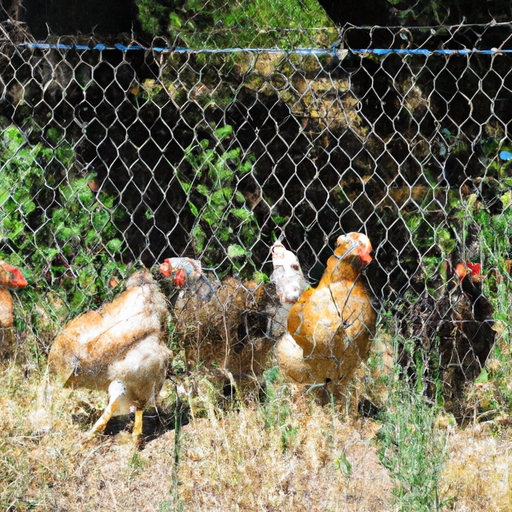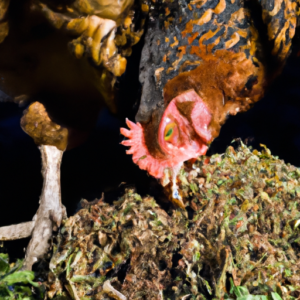
You’ve got a flock of chickens and you’re excited to introduce some little pullets to the crew! But how do you ensure a smooth integration and minimize any squabbles or pecking order disputes? In this article, we’ll explore the best practices for introducing young pullets to an existing flock, including tips on quarantine, gradual introductions, and establishing a new pecking order. Whether you’re a seasoned chicken keeper or a beginner, these guidelines will help you create a harmonious and happy flock in no time.

Prepare the Coop and Run
Before introducing young pullets to the existing flock, it is essential to prepare the coop and run to ensure a smooth integration process. Clean and disinfect the coop and run thoroughly to minimize the risk of disease transmission. Remove any old bedding, manure, and debris from the coop, and sanitize the surfaces with a poultry-safe disinfectant.
Adding additional roosts and nesting boxes is also crucial to accommodate the growing flock. Provide enough roosting space for all the birds, ensuring they have enough room to perch comfortably. Similarly, ensure there are enough nesting boxes to meet the needs of the hens when they start laying eggs. Adequate roosting and nesting spaces not only promote a more harmonious environment but also reduce the risk of territorial disputes.
Lastly, it is important to provide ample food and water stations for both the existing flock and the new pullets. Having multiple feeding and watering areas helps prevent competition and ensures that all birds have access to essential resources. Make sure the stations are easily accessible and clean, and regularly replenish the feed and water to promote optimal health and well-being.
Quarantine Period
Before introducing new pullets to the rest of the flock, it is crucial to quarantine them to minimize the risk of introducing diseases or parasites. Isolate the new pullets in a separate coop or designated area away from the existing flock. This quarantine period allows you to observe the new pullets for any signs of illness or parasites before exposing them to the rest of the birds.
During the quarantine period, closely monitor the new pullets for any signs of respiratory distress, diarrhea, abnormal feathering, or lethargy. If any signs of illness are detected, seek advice from a poultry veterinarian and postpone their introduction to the flock until they are deemed healthy.
Additionally, monitor for parasites such as mites or lice during the quarantine period. Regularly check the birds for any signs of infestation, such as feather damage or excessive scratching. If any parasites are found, treat the new pullets accordingly, and ensure they are parasite-free before introducing them to the rest of the birds.

Gradual Introduction
To minimize stress and increase the chances of a successful integration, it is best to introduce young pullets to the existing flock gradually. Start by allowing the pullets to see and hear the existing flock without direct contact. This can be achieved by placing the pullets in a separate but adjacent area, such as a wire mesh pen or a divided coop.
By doing this, the birds can become familiar with each other’s presence and establish a level of comfort before direct interaction. This gradual introduction helps reduce the chances of aggressive behavior and promotes a smoother integration process.
It is generally recommended to introduce the pullets to the existing flock when they are around 16 weeks old. At this age, they are typically large enough to hold their own against older hens and are less likely to be bullied. However, if there are significant size differences between the pullets and the existing birds, it may be necessary to wait longer to ensure their safety.
Supervised Interactions
Once the pullets have become acquainted with the existing flock, it is time to begin supervised interactions. It is crucial to supervise the initial interactions between the pullets and the older hens to prevent any aggressive behavior or injury. Observe their behavior closely and intervene if necessary.
During the initial interactions, it is best to allow short and supervised visits between the pullets and the older hens. This can be done by opening the divider between their separate spaces for limited periods, gradually increasing the duration of their interactions over time. This approach allows the birds to become familiar with each other in a controlled environment.
Any signs of aggression, such as excessive pecking or chasing, should be addressed immediately. If a hen shows aggression towards the pullets, consider providing hiding spots or visual barriers within the coop and run. This allows the pullets to escape or take cover if they feel threatened. Anti-pecking products, such as peepers or pinless peepers, can also be used to discourage aggressive behavior in certain cases.

Monitor for Aggression
Throughout the integration process, it is essential to closely monitor the flock for any signs of aggression towards the pullets. It is not uncommon for existing hens to establish a pecking order when new birds are introduced. However, excessive aggression can lead to serious injuries and a hostile environment for the pullets.
If you notice any severe or persistent aggression towards the pullets, it may be necessary to separate the aggressive birds from the rest of the flock temporarily. This allows the pullets to integrate more peacefully and ensures their safety. Remember, a harmonious and stress-free environment promotes the well-being of all birds.
Maintain Adequate Space
Providing adequate space for all the birds is crucial for their overall well-being and reduces the risk of aggressive behavior due to overcrowding. Make sure the coop and run have enough space for each bird to move, stretch their wings, and engage in natural behaviors.
Consider the recommended space requirements for each bird and provide multiple feeding and watering stations to minimize competition. Overcrowding can lead to increased stress, aggression, and the spread of diseases. Ensure there is enough space for all the birds to thrive and coexist peacefully.
Establish a Routine
Establishing a routine for feeding, cleaning, and social interaction is beneficial for the well-being of the entire flock. Stick to a consistent feeding schedule to maintain their nutritional needs and promote a sense of security. Regularly clean the coop and run to provide a clean and healthy living environment for the birds.
In addition to a feeding routine, establish a predictable daily routine. Chickens thrive on consistency, and having a structured schedule helps reduce stress and anxiety. This can include letting the birds out to free-range at specific times, providing treats or enrichment activities, and closing the coop at night. A routine helps the birds feel secure and establishes order within the flock.
Provide Adequate Nutrition
Proper nutrition is essential for the growth and development of young pullets. Offer a balanced diet that meets their nutritional needs, including essential vitamins and minerals. Choose a feed specifically formulated for young pullets to ensure they receive the appropriate levels of protein and calcium for healthy growth and egg production.
Additionally, consider providing necessary supplements if required. Some pullets may benefit from additional calcium supplementation, especially when they start laying eggs. Consult with a poultry nutritionist or veterinarian to determine if any supplements are needed based on the specific needs of your flock and the quality of their diet.
Care for Social Hierarchy
When introducing new pullets to the existing flock, it is important to allow for the establishment of a natural pecking order. Chickens are social animals with a hierarchical structure, and their social dynamics need to be respected. Allow the birds to establish their own pecking order, which helps reduce conflict and establish a sense of order within the flock.
While some pecking and chasing are normal during this adjustment period, it is essential to minimize excessive aggression or bullying. Ensure the pullets have a chance to retreat and take cover if they feel threatened. Providing hiding spots, such as wooden crates or dense vegetation, can help create safe spaces within the coop and run.
If a particular bird displays persistent aggression towards the pullets, it may be necessary to separate and reintroduce her to the flock later. Remember, a balanced and harmonious flock leads to healthier and happier chickens.
Continued Monitoring
Even after successful integration, it is important to regularly observe and assess the behavior of the entire flock. Monitor their interactions, feeding habits, and overall behavior for any changes or signs of stress. Check for abnormal feathering, weight loss, or any signs of illness.
Address any issues or concerns promptly to maintain the well-being of the birds. This includes seeking veterinary advice if needed, adjusting the flock’s housing or feeding arrangements if overcrowding becomes an issue, and monitoring for potential parasites or diseases.
By implementing these best practices, you can ensure a smooth and successful integration process when introducing young pullets to an existing flock. Building a strong and harmonious flock not only promotes the overall health and well-being of the birds but also creates a pleasant and enjoyable experience for poultry enthusiasts like you. So take the time to prepare, observe, and care for your flock, and watch them thrive in their new social dynamic.






